#vRealize Operations Manager
Explore tagged Tumblr posts
Text
VMware vRealize Suite India, IT operations management, Radiant VMware partner
Explore how VMware vRealize Suite enhances IT operations management in India with Radiant as a trusted partner. Learn about VMware prices, licenses, and subscriptions available in India.
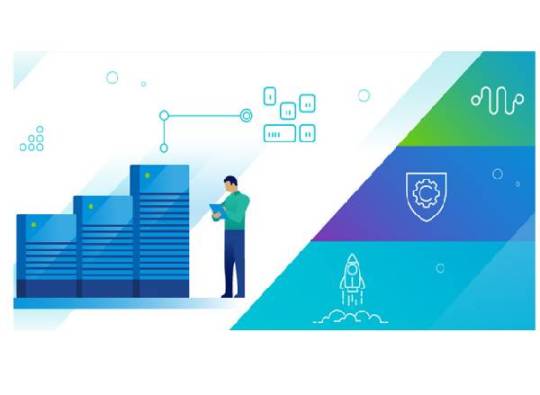
#VMware vRealize Suite India#IT operations management solutions#VMware prices Indi#VMware licenses#Radiant VMware partner
0 notes
Text
Cloud Performance Management Market Size, Share, Analysis, Forecast, and Growth Trends to 2032 Identify Emerging Technology Leaders
The Cloud Performance Management Market size was valued at USD 2.00 billion in 2023 and is expected to reach USD 8.25 billion by 2032, with a growing at a CAGR of 17.06% over the forecast period 2024-2032.
The Cloud Performance Management Market is experiencing significant momentum as enterprises across various sectors rapidly adopt cloud technologies to streamline operations and boost agility. As businesses transition from traditional infrastructure to cloud environments, managing and optimizing performance in real-time has become essential to ensure service reliability, end-user satisfaction, and operational efficiency. This has led to a surge in demand for advanced cloud performance tools that provide visibility, automation, and intelligent analytics.
Cloud Performance Management Market is witnessing a shift towards proactive monitoring and AI-driven insights, empowering organizations to predict and resolve performance bottlenecks before they impact operations. With the growing complexity of hybrid and multi-cloud ecosystems, vendors are focusing on innovative solutions that can seamlessly integrate across platforms and deliver unified performance metrics. This market is not just growing in size but also evolving in depth and capability.
Get Sample Copy of This Report: https://www.snsinsider.com/sample-request/3773
Market Keyplayers:
VMware (vRealize Operations, CloudHealth)
HPE (Hewlett Packard Enterprise) (Cloud Optimizer, InfoSight)
Oracle (Oracle Management Cloud, Oracle Cloud Observability and Management Platform)
CA Technologies (Broadcom Inc.) (DX AIOps, App Synthetic Monitor)
Microsoft (Azure Monitor, System Center Operations Manager)
IBM (Instana, Turbonomic)
AppDynamics (Cisco Systems) (AppDynamics Business iQ, Application Performance Monitoring)
Riverbed Technology (SteelCentral, AppResponse)
BMC Software (Helix AIOps, TrueSight)
HR Cloud Inc. (Onboard, Workmates)
Dynatrace (Dynatrace Software Intelligence Platform, Synthetic Monitoring)
NamLabs Technologies Pvt Ltd (Site24x7, ManageEngine Applications Manager)
Citrix Systems Inc. (Citrix ADM, Citrix SD-WAN)
Commvault (Metallic SaaS, HyperScale X)
Lanteria LLC (Performance, HR Portal)
New Relic (New Relic One, APM)
Splunk (Splunk Observability Cloud, IT Service Intelligence)
Datadog (Cloud Monitoring, Log Management)
SolarWinds (Server & Application Monitor, Network Performance Monitor)
PagerDuty (Incident Response, Digital Operations Management)
Market Analysis
The market is shaped by the increasing digital transformation initiatives and the need for robust, scalable IT infrastructure. Enterprises are leveraging cloud performance management tools to ensure optimal resource utilization, enhance application delivery, and support uninterrupted business continuity. The market is highly competitive, with key players focusing on automation, predictive analytics, and real-time monitoring to differentiate their offerings. Moreover, regulatory compliance and data security remain critical factors driving product development and adoption.
Market Trends
Surge in demand for AI and machine learning-powered performance analytics
Growing adoption of multi-cloud and hybrid cloud strategies
Integration of observability platforms with performance management solutions
Emphasis on DevOps and continuous delivery environments
Rise of edge computing and its impact on cloud performance tools
Expansion of SaaS-based performance monitoring solutions
Increasing focus on cost optimization and ROI measurement
Market Scope
The scope of the Cloud Performance Management Market encompasses various industry verticals including IT and telecom, healthcare, BFSI, retail, manufacturing, and government. It covers a wide range of deployment models such as public, private, and hybrid clouds. Solutions include network performance monitoring, application performance management (APM), infrastructure monitoring, and workload automation. Enterprises of all sizes are integrating these solutions into their operations to enhance productivity, improve uptime, and gain actionable business intelligence.
Market Forecast
Over the forecast period, the market is expected to show sustained momentum driven by technological innovation, strategic partnerships, and the rising importance of seamless user experience. Advanced analytics, AI integration, and end-to-end observability will remain key differentiators among market leaders. As businesses scale their digital operations, the demand for agile, reliable, and intelligent cloud performance solutions will continue to expand across global markets.
Access Complete Report: https://www.snsinsider.com/reports/cloud-performance-management-market-3773
Conclusion
The Cloud Performance Management Market is not just a reflection of the growing reliance on cloud computing but a testament to the need for smarter, faster, and more adaptive IT environments. As organizations push toward innovation and resilience, cloud performance management stands as a critical pillar enabling sustainable growth. Forward-looking companies that prioritize performance, visibility, and agility in their cloud journey will be best positioned to lead in the digital age.
About Us:
SNS Insider is one of the leading market research and consulting agencies that dominates the market research industry globally. Our company's aim is to give clients the knowledge they require in order to function in changing circumstances. In order to give you current, accurate market data, consumer insights, and opinions so that you can make decisions with confidence, we employ a variety of techniques, including surveys, video talks, and focus groups around the world.
Contact Us:
Jagney Dave - Vice President of Client Engagement
Phone: +1-315 636 4242 (US) | +44- 20 3290 5010 (UK)
#Cloud Performance Management Market#Cloud Performance Management Market Scope#Cloud Performance Management Market Share#Cloud Performance Management Market Trends
0 notes
Text
How Do You Secure Your Server from Malicious ESX Scripts?
Securing your server from malicious ESX scripts is essential in ensuring the safety and integrity of your data and services. ESX (Elastic Sky X) is a virtualization platform often used in server environments, enabling multiple virtual machines to run on a single host. While ESX provides great flexibility and efficiency, it can also be vulnerable to attacks, particularly through malicious scripts. These scripts, if not properly managed, can compromise the security of your server, lead to data breaches, or disrupt the smooth operation of your virtualized environment.
Here’s a detailed guide on how to secure your server from malicious esx scripts:

Keep Your System Updated
The first and most crucial step in securing your server is to keep your ESX host and all its components up to date. VMware frequently releases patches and updates to address security vulnerabilities, performance improvements, and bug fixes. Regularly check for updates and ensure that all patches are applied promptly. Neglecting these updates can leave your server open to exploitation from attackers using known vulnerabilities.
Use Secure Configurations
Another key to securing your ESX environment is ensuring that your server is configured securely. This includes configuring the ESXi firewall, disabling unnecessary services, and following VMware’s security best practices. By turning off unnecessary services, you limit the number of potential attack vectors. VMware provides a comprehensive security guide that outlines recommended configurations for hardening your ESX installation. Follow these guidelines to ensure your system is as secure as possible.
Enable ESX Host Firewall
The ESX firewall acts as a barrier between your server and any potential intrusions from malicious actors. Ensure that the firewall is configured properly to block unnecessary ports and only allow trusted traffic. Additionally, you can configure the firewall to log suspicious activity, providing valuable information in case of a security breach. Regularly review firewall logs to spot any unusual activity.
Control User Access and Privileges
One of the most common ways attackers gain access to ESX servers is through compromised user accounts or excessive privileges. Implement the principle of least privilege (POLP) by ensuring that users and administrators only have access to the resources they need. Limit access to critical system components and ensure that users cannot execute scripts unless absolutely necessary. Use role-based access controls (RBAC) to assign permissions based on job responsibilities. Moreover, regularly audit user accounts and remove any unused or inactive accounts to minimize potential vulnerabilities.
Monitor and Analyze Logs
Effective logging and monitoring are essential for identifying and responding to malicious activity quickly. Set up centralized logging for all ESX hosts and monitor these logs regularly for signs of abnormal behavior, such as unauthorized access attempts, failed login attempts, or unusual script executions. VMware vRealize Log Insight can help you manage and analyze logs efficiently, enabling you to spot malicious activity in real-time. Promptly investigate and address any suspicious log entries.
Scan for Malicious Scripts
Malicious ESX scripts are often introduced by attackers who exploit vulnerabilities in your environment. To prevent such threats, regularly scan your ESX server for suspicious scripts or files. Automated malware detection tools and anti-virus software can help detect and quarantine malicious files before they can cause damage. Ensure that any scripts running on your server are from trusted sources, and review them periodically to ensure they haven’t been tampered with.
Use Secure Boot and Trusted Execution
Secure boot is an essential security feature that prevents unauthorized firmware, bootloaders, and other malicious code from loading during the boot process. Ensure that secure boot is enabled on your ESX host, as it helps protect against rootkits and boot-time malware. Additionally, using trusted execution environments such as Intel TXT (Trusted Execution Technology) or AMD SEV (Secure Encrypted Virtualization) can further protect the integrity of your ESX server and its virtual machines from malicious scripts.
Use Virtual Machine Isolation
In environments where multiple virtual machines (VMs) are running on the same ESX host, it is essential to ensure proper isolation between VMs. This minimizes the risk of an attacker gaining access to other VMs via a compromised script. Configuring virtual machine isolation settings, such as enabling virtual machine lockdown mode and using a separate network for sensitive VMs, will significantly reduce the chance of a malicious script spreading across your environment.
Backup Regularly
Even with all the security measures in place, it’s always a good practice to have a reliable backup strategy in case of a breach. Regularly back up your ESX server and its virtual machines to secure, offsite storage. This ensures that if a malicious script causes system corruption or data loss, you can quickly restore your system to its previous state. Automate your backups and perform regular tests to ensure data integrity.
Conclusion
Securing your ESX server from malicious scripts requires a comprehensive approach that involves proactive monitoring, secure configurations, and regular updates. By following these best practices and maintaining a vigilant stance against potential threats, you can safeguard your virtualized environment from the damaging effects of malicious ESX scripts. Regular auditing, user privilege management, and the use of advanced security features like secure boot and trusted execution environments will further strengthen your defenses and help you maintain a secure, stable ESX server environment.
1 note
·
View note
Text
Invigorate Your IT Potential with VMware Training from Ascendient Learning
VMware is at the forefront of virtualization solutions, powering software-defined data centers, hybrid clouds, and secure infrastructure management for enterprises worldwide. With over 500,000 customers globally, including all Fortune 500 companies, VMware expertise significantly enhances your value as an IT professional.
Ascendient Learning, named VMware's North American Learning Partner of the Year in 2023, offers comprehensive, industry-leading VMware training to help you stay competitive.
Comprehensive VMware Training at Ascendient Learning
Ascendient Learning offers an extensive portfolio of VMware-certified courses covering the most critical VMware technologies. Training is available for:
vSphere: The foundational technology for software-defined data centers. Courses like "VMware vSphere: Install, Configure, Manage [V8]" and "Operate, Scale and Secure [V8]" provide critical virtualization and management skills.
NSX: VMware NSX courses teach vital network virtualization and cybersecurity skills. Popular courses include "VMware NSX: Install, Configure, Manage [V4.0]" and "NSX: Troubleshooting and Operations."
vSAN: This training equips professionals to efficiently deploy and manage software-defined storage solutions. Courses like "VMware vSAN: Install, Configure, Manage [V8]" and "VMware vSAN: Troubleshooting [V8]" ensure you’re skilled in the latest storage innovations.
vRealize Suite: Ascendient offers training on advanced cloud automation and orchestration tools, crucial for streamlining IT processes and infrastructure management.
Tanzu and Kubernetes: Ascendient’s Tanzu courses, including "VMware vSphere with Tanzu: Deploy, Configure, Manage," empower IT teams to build and manage modern cloud-native applications efficiently.
VMware Aria Suite: Training in VMware Aria helps professionals achieve advanced operational insights and efficient cloud automation management, including "VMware Aria Automation: Orchestration and Extensibility."
Flexible Training Formats Designed for Real-Life Schedules
Ascendient Learning recognizes the need for training that adapts to your busy professional life. Therefore, VMware training is offered in various convenient formats:
Instructor-Led Virtual Sessions: Participate interactively with expert instructors in real-time virtual environments.
Guaranteed-to-Run Classes: Ascendient provides one of North America's largest Guaranteed-to-Run (GTR) VMware course schedules, offering reliability and predictable scheduling.
Self-Paced Online Learning: Ideal for professionals seeking complete flexibility, these courses allow learners to progress at their own pace without compromising content quality or depth.
In-Person Classroom Training: Engage directly with instructors and peers through traditional classroom-based training, fostering collaboration and hands-on practice.
Real Benefits: Proven ROI for Professionals and Organizations
Investing in VMware training with Ascendient Learning delivers tangible benefits. According to recent research, organizations with VMware-trained teams experience increased productivity, improved employee satisfaction, and reduced employee turnover. Ascendient learners have successfully leveraged VMware skills to secure promotions, negotiate salary increases, and transition into high-demand roles like Solutions Architects, Systems Engineers, Cloud Architects, and Network Specialists.
For instance, companies implementing VMware vSAN and NSX through certified professionals have reported drastic improvements in data center efficiency, significantly lowering costs while boosting infrastructure performance and security.
Your Path to VMware Certification Starts Here
VMware-certified professionals are consistently in high demand. Achieving VMware certification through Ascendient Learning positions you strategically within the IT landscape, opening doors to better opportunities, higher salaries, and greater professional satisfaction. The industry increasingly values and rewards VMware expertise, making this training a strategic investment for both individual career growth and organizational success.
Take the next step today. Join the thousands who have accelerated their careers and transformed their organizations through VMware training at Ascendient Learning.
Enroll with Ascendient Learning and master VMware technology to shape your future in IT leadership.
For more information visit: https://www.ascendientlearning.com/it-training/vmware
0 notes
Text
Cloud Performance Management Market Expansion, Industry Statistics, and Strategic Insights 2032
The Cloud Performance Management Market size was valued at USD 2.00 billion in 2023 and is expected to reach USD 8.25 billion by 2032, with a growing at a CAGR of 17.06% over the forecast period 2024-2032
Cloud Performance Management is revolutionizing IT infrastructure by optimizing cloud resources, ensuring scalability, and enhancing operational efficiency. With businesses migrating to cloud-based solutions, the demand for effective performance management tools is rising rapidly. Companies are increasingly investing in advanced analytics, AI-driven monitoring, and automation to enhance cloud performance and reduce downtime.
Cloud Performance Management Market continues to gain traction as organizations seek to improve service reliability, minimize latency, and ensure seamless cloud operations. The growing complexity of multi-cloud and hybrid environments is pushing enterprises to adopt intelligent monitoring solutions. As cloud adoption accelerates across industries, businesses are prioritizing real-time insights and automation to maximize efficiency.
Get Sample Copy of This Report: https://www.snsinsider.com/sample-request/3773
Market Keyplayers:
VMware (vRealize Operations, CloudHealth)
HPE (Hewlett Packard Enterprise) (Cloud Optimizer, InfoSight)
Oracle (Oracle Management Cloud, Oracle Cloud Observability and Management Platform)
CA Technologies (Broadcom Inc.) (DX AIOps, App Synthetic Monitor)
Microsoft (Azure Monitor, System Center Operations Manager)
IBM (Instana, Turbonomic)
AppDynamics (Cisco Systems) (AppDynamics Business iQ, Application Performance Monitoring)
Riverbed Technology (SteelCentral, AppResponse)
BMC Software (Helix AIOps, TrueSight)
HR Cloud Inc. (Onboard, Workmates)
Dynatrace (Dynatrace Software Intelligence Platform, Synthetic Monitoring)
NamLabs Technologies Pvt Ltd (Site24x7, ManageEngine Applications Manager)
Citrix Systems Inc. (Citrix ADM, Citrix SD-WAN)
Commvault (Metallic SaaS, HyperScale X)
Lanteria LLC (Performance, HR Portal)
New Relic (New Relic One, APM)
Splunk (Splunk Observability Cloud, IT Service Intelligence)
Datadog (Cloud Monitoring, Log Management)
SolarWinds (Server & Application Monitor, Network Performance Monitor)
PagerDuty (Incident Response, Digital Operations Management)
Market Trends Driving Growth
1. Adoption of AI-Driven Monitoring
AI-powered cloud management tools are improving predictive analytics, enabling businesses to detect and resolve performance issues before they impact operations.
2. Growth of Multi-Cloud and Hybrid Environments
Organizations are diversifying their cloud strategies, requiring robust performance management solutions that ensure seamless integration across multiple cloud platforms.
3. Focus on Real-Time Performance Optimization
Enterprises are leveraging real-time data analytics and automation to proactively manage workloads, optimize cloud resources, and prevent downtime.
4. Rising Demand for Cost-Effective Cloud Solutions
With increasing cloud expenses, businesses are investing in tools that help optimize performance while reducing operational costs through automated resource allocation.
Enquiry of This Report: https://www.snsinsider.com/enquiry/3773
Market Segmentation:
By Component
Solutions
Services
By Deployment Mode
Public Cloud
Private Cloud
By Enterprise Size
SMEs
Large Enterprises
By Vertical
Banking, Financial Services, and Insurance
IT and telecom
Government and Public Sector
Manufacturing
Retail and Consumer Goods
Healthcare and Life Sciences
Energy and Utilities
Market Analysis and Current Landscape
Increasing Cloud Adoption: Businesses are shifting from traditional IT infrastructure to cloud-based environments, creating a demand for performance monitoring tools.
Advancements in AI and Automation: Intelligent analytics and automated performance tuning are helping companies optimize cloud workloads efficiently.
Rising Cybersecurity Concerns: Organizations are prioritizing secure and compliant cloud performance management solutions to mitigate risks.
Demand for Scalability: Companies need scalable cloud solutions that adjust dynamically based on real-time demand.
Despite its rapid expansion, the market faces challenges such as integration complexities and the need for skilled professionals to manage cloud performance tools. However, ongoing technological advancements are addressing these concerns, making cloud performance management more accessible and efficient.
Future Prospects: What Lies Ahead?
1. AI-Powered Autonomous Cloud Management
Cloud platforms will increasingly rely on AI and machine learning to automate workload optimization and self-healing cloud environments.
2. Enhanced Edge Computing Performance
With the rise of edge computing, businesses will require advanced cloud performance management solutions to ensure real-time processing efficiency.
3. Increased Adoption of Serverless Computing
Companies will move toward serverless architectures, further driving the need for performance monitoring tools that optimize cloud functions dynamically.
4. Blockchain for Secure Cloud Operations
Blockchain technology is expected to enhance transparency, security, and data integrity in cloud performance management.
Access Complete Report: https://www.snsinsider.com/reports/cloud-performance-management-market-3773
Conclusion
The Cloud Performance Management market is poised for substantial growth as enterprises prioritize efficiency, security, and scalability in cloud computing. Companies investing in AI, automation, and real-time analytics will lead the industry’s evolution. As businesses continue to embrace cloud-first strategies, the demand for intelligent performance management solutions will remain strong, shaping the future of cloud computing.
About Us:
SNS Insider is one of the leading market research and consulting agencies that dominates the market research industry globally. Our company's aim is to give clients the knowledge they require in order to function in changing circumstances. In order to give you current, accurate market data, consumer insights, and opinions so that you can make decisions with confidence, we employ a variety of techniques, including surveys, video talks, and focus groups around the world.
Contact Us:
Jagney Dave - Vice President of Client Engagement
Phone: +1-315 636 4242 (US) | +44- 20 3290 5010 (UK)
#Cloud Performance Management market#Cloud Performance Management market Scope#Cloud Performance Management market Growth#Cloud Performance Management market Trends
0 notes
Text
Optimizing Oracle Licensing on VMware with Oracle BYOL
Oracle databases power many enterprises worldwide, making them an essential component of business operations. However, Oracle licensing can be complex, especially when running Oracle workloads on VMware. Organizations looking to optimize costs and maintain compliance must understand how to leverage Oracle Bring Your Own License (BYOL) for VMware environments. This article will explore how Oracle BYOL works, its benefits, and best practices for managing Oracle licensing on VMware.
Understanding Oracle BYOLOracle BYOL (Bring Your Own License) allows organizations to use their existing Oracle licenses in cloud or virtualized environments, including VMware. This model enables businesses to migrate their on-premises Oracle licenses to VMware infrastructure while staying compliant with Oracle's licensing policies. Unlike Oracle Cloud licensing, BYOL gives enterprises greater control and flexibility over their licensing costs and deployment options.
The Complexity of Oracle Licensing on VMwareOracle Licensing Vmware ware has been a topic of debate due to OracleÕs ambiguous policies. Oracle typically licenses software based on physical hardware rather than virtualized resources. This means organizations running Oracle databases on VMware could face licensing challenges, such as: Processor-Based Licensing: Oracle often requires licenses for all physical processors in a VMware cluster, even if Oracle workloads are not running on every host. Soft Partitioning Considerations: VMware is considered "soft partitioning" by Oracle, meaning licensing is required for all potential hosts where Oracle software could run. Compliance Risks: Oracle audits can result in unexpected costs if licensing requirements are misunderstood or misapplied.
Leveraging Oracle BYOL on VMwareBy using Oracle BYOL, businesses can maximize the value of their existing Oracle licenses while running workloads on VMware. Here are key ways to optimize licensing with Oracle BYOL:
1. Understand Licensing PoliciesBefore deploying Oracle on VMware, organizations must thoroughly understand OracleÕs licensing policies. While Oracle has not explicitly certified VMware, many enterprises successfully run Oracle workloads on VMware infrastructure under BYOL. 2. Optimize VMware Clusters for Oracle Workloads
To avoid unnecessary licensing costs, organizations should consider: Dedicated Oracle Clusters: Creating separate VMware clusters for Oracle workloads to contain licensing scope. Affinity and Anti-Affinity Rules: Restricting Oracle VMs to specific hosts to prevent compliance risks. Monitoring VM Mobility: Keeping track of VM movement to ensure that Oracle workloads remain within licensed boundaries. 3. Negotiate Licensing AgreementsBusinesses should work closely with Oracle representatives to negotiate clear licensing terms when using Oracle BYOL on VMware. Proper documentation of agreements ensures compliance and prevents unexpected costs during audits.
4. Leverage Third-Party Tools for ComplianceUsing license management and compliance tools can help organizations track Oracle deployments on VMware, ensuring they remain within licensed limits. Some popular tools include:
Oracle License Management Services (LMS)VMwareÕs vRealize SuiteThird-party audit support services5. Consider Cloud IntegrationFor organizations looking to extend their VMware environments to the cloud, Oracle Cloud VMware Solution (OCVS) allows running VMware workloads while maintaining Oracle BYOL benefits. This hybrid approach provides flexibility and cost efficiency.
Benefits of Using Oracle BYOL on VMware1. Cost SavingsOracle BYOL eliminates the need to purchase additional Oracle licenses, reducing software expenses. By optimizing VMware clusters, businesses can further minimize licensing costs.
2. Greater FlexibilityWith Oracle BYOL, organizations have more deployment options, allowing them to run Oracle workloads on-premises or in hybrid cloud environments.
3. Scalability and PerformanceVMware enables businesses to scale their Oracle workloads efficiently while maintaining high availability and performance.
4. Compliance ManagementBy implementing best practices such as dedicated clusters and licensing audits, enterprises can avoid compliance risks and potential financial penalties. Common Misconceptions About Oracle Licensing on VMware1. "VMware Is Not Supported by Oracle"Oracle does not officially certify VMware, but many enterprises successfully run Oracle workloads on VMware infrastructure. Proper documentation and licensing strategies can ensure compliance.
2. "Oracle Requires Licensing for the Entire VMware Environment"While Oracle may claim licensing is required for all hosts in a VMware environment, organizations can mitigate costs by creating dedicated Oracle clusters and enforcing VM restrictions.
"Oracle Can Demand Additional Licenses During an Audit"Oracle audits can be challenging, but businesses that proactively manage licensing agreements and maintain documentation can prevent unnecessary license purchases.
Best Practices for Oracle Licensing on VMware with BYOLConduct a License Assessment: Regularly review Oracle license agreements and deployments to ensure compliance. Optimize VMware Clusters: Use dedicated Oracle clusters to minimize licensing costs. Implement Affinity Rules: Restrict Oracle workloads to licensed hosts using VMwareÕs Affinity rules. Monitor Workload Migration: Prevent Oracle VMs from moving to unlicensed hosts. Use Third-Party Audit Support: Seek expert guidance during Oracle audits to defend compliance. Negotiate Licensing Terms: Work with Oracle representatives to clarify BYOL terms for VMware deployments. Stay Updated on Policy Changes: Monitor Oracle licensing updates to ensure ongoing compliance
. ConclusionManaging Oracle licensing on VMware requires a strategic approach to minimize costs and ensure compliance. By leveraging Oracle BYOL, organizations can optimize their existing Oracle investments while running workloads efficiently on VMware infrastructure. Understanding OracleÕs licensing policies, implementing best practices, and using compliance tools will help businesses navigate the complexities of Oracle licensing on VMware. With the right approach, enterprises can achieve both cost efficiency and operational flexibility while maintaining compliance with OracleÕs licensing requirements.
0 notes
Text
vRops Capacity Report
Merhaba, bu yazımda sizlere vRops capacity report konusundan kısaca bahsedeceğim. vRealize Operations Manager (vROps) üzerinde sanal sunucuların kapasite raporunu çıkarmak için şu adımları izleyebilirsiniz: vROps’a Giriş Yapın: Web tarayıcınızdan vROps arayüzüne giriş yapın. Dashboard (Panolar) Bölümüne Geçin: Ana menüden “Dashboard” veya “Panolar” sekmesine gidin. Raporlar Sekmesine…
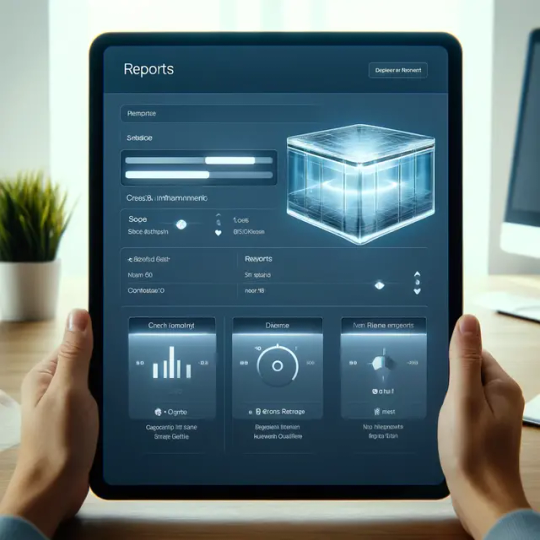
View On WordPress
0 notes
Text
Exploring The World Of Software-Defined Data Centers
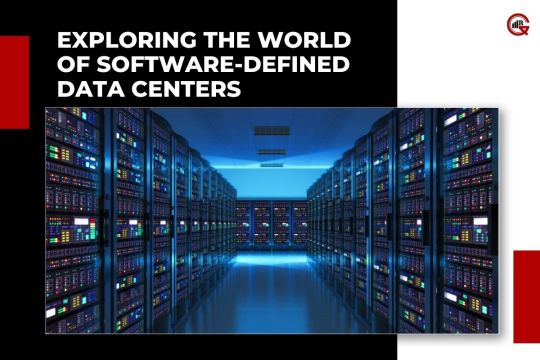
(Source – Rack Solutions)
In today’s digital age, where data is hailed as the new currency, businesses are constantly seeking innovative ways to manage, store, and process vast amounts of information efficiently and securely. Enter the Software-Defined Data Center (SDDC) – a revolutionary approach to data center infrastructure that promises agility, scalability, and automation like never before. In this article, we delve into the concept of Software-Defined Data Centers, its key components, benefits, challenges, and the future outlook for this transformative technology.
Understanding Software-Defined Data Centers:
At its core, a Software-Defined Data Center (SDDC) is an architectural framework that abstracts and virtualizes the entire data center infrastructure, including compute, storage, networking, and security resources. Unlike traditional data centers, where hardware dictates functionality and scalability, an SDDC decouples infrastructure from hardware, enabling administrators to manage and provision resources programmatically through software-defined policies and automation.
Key Components of SDDC:
Compute Virtualization:
Compute virtualization forms the foundation of an SDDC, allowing multiple virtual machines (VMs) to run on a single physical server or cluster of servers.
Hypervisor technologies, such as VMware vSphere, Microsoft Hyper-V, and KVM (Kernel-based Virtual Machine), abstract compute resources and provide a platform for deploying and managing VMs.
Software-Defined Storage (SDS):
SDS abstracts storage resources from the underlying hardware, enabling dynamic allocation, provisioning, and management of storage capacity and performance.
Technologies like VMware vSAN, Nutanix Acropolis, and OpenStack Swift provide scalable, distributed storage solutions with features like data deduplication, replication, and automated tiering.
Software-Defined Networking (SDN):
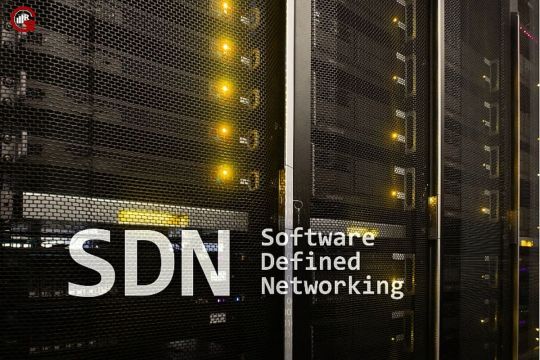
SDN decouples network control from the underlying hardware and centralizes network management through software-defined policies and programmable APIs.
Platforms such as Cisco ACI (Application Centric Infrastructure), VMware NSX, and OpenFlow-based controllers enable network virtualization, micro-segmentation, and dynamic network provisioning.
Automation and Orchestration:
Automation and orchestration tools, such as VMware vRealize Automation, Ansible, and Kubernetes, streamline data center operations by automating routine tasks, workflows, and resource provisioning.
These tools empower administrators to define policies, templates, and workflows for deploying, scaling, and managing infrastructure and applications.
Benefits of Software-Defined Data Centers:
Agility and Flexibility:
SDDCs offer unparalleled agility and flexibility, enabling organizations to provision and scale resources on-demand to meet changing business requirements.
With automated provisioning and self-service portals, IT teams can rapidly deploy applications and services without manual intervention, reducing time-to-market and improving agility.
Cost Efficiency:
By abstracting hardware and embracing commodity components, Software-Defined Data Centers lower capital expenditures (CapEx) and operational expenses (OpEx) associated with traditional data center infrastructure.
Consolidating workloads onto fewer physical servers and optimizing resource utilization leads to cost savings through reduced hardware procurement, power consumption, and data center footprint.
Scalability and Elasticity:

Software-Defined Data Centers are inherently scalable and elastic, allowing organizations to scale resources up or down dynamically in response to workload demands.
By pooling and abstracting resources across the data center, SDDCs support elastic scaling of compute, storage, and networking resources, ensuring optimal performance and resource utilization.
Enhanced Security and Compliance:
With network micro-segmentation and policy-based controls, SDDCs strengthen security posture by isolating workloads, enforcing access controls, and implementing encryption and threat detection mechanisms.
Compliance frameworks, such as PCI DSS, HIPAA, and GDPR, are easier to adhere to in Software-Defined Data Centers, as policies and controls can be centrally defined, enforced, and audited across the entire infrastructure.
Challenges and Considerations:
Complexity and Skill Gap:
Implementing and managing Software-Defined Data Centers require specialized skills and expertise in virtualization, networking, automation, and cloud technologies.
Organizations may face challenges in recruiting and retaining talent with the requisite knowledge and experience to design, deploy, and operate SDDC environments effectively.
Integration and Interoperability:
Integrating disparate technologies and legacy systems into a cohesive SDDC architecture can be complex and time-consuming.
Ensuring interoperability between hardware, software, and management tools from different vendors requires careful planning, testing, and integration efforts.
Performance and Latency:
While SDDCs offer scalability and flexibility, organizations must carefully monitor and manage performance to avoid latency and bottlenecks.
Network latency, storage I/O performance, and VM sprawl are common challenges that can impact application performance and user experience in SDDC environments.
Future Outlook:
The future of Software-Defined Data Centers (SDDCs) looks promising, with ongoing advancements in virtualization, automation, and cloud-native technologies driving innovation and adoption. Key trends shaping the future of SDDCs include:
Hybrid and Multi-Cloud Adoption:
Organizations are embracing hybrid and multi-cloud strategies, leveraging SDDC principles to build and manage distributed, heterogeneous environments across on-premises data centers and public cloud platforms.
Edge Computing and IoT:
The proliferation of edge computing and Internet of Things (IoT) devices is driving the need for edge-native SDDC solutions that deliver computing, storage, and networking capabilities at the edge of the network.
Artificial Intelligence and Machine Learning:

AI and ML technologies are being integrated into SDDC platforms to automate operations, optimize resource allocation, and improve predictive analytics for capacity planning and performance optimization.
Zero-Trust Security:
Zero-trust security models are becoming increasingly important in SDDCs, with a focus on identity-centric security, encryption, and continuous authentication to protect against evolving cyber threats and data breaches.
Conclusion:
Software-Defined Data Centers (SDDCs) represent a paradigm shift in data center infrastructure, offering organizations unprecedented agility, scalability, and automation capabilities. By abstracting and virtualizing computing, storage, networking, and security resources, SDDCs empower businesses to optimize resource utilization, streamline operations, and accelerate digital transformation initiatives. While challenges such as complexity and integration persist, the benefits of SDDCs in terms of cost efficiency, flexibility, and security position them as a cornerstone of modern IT infrastructure in the digital era.
0 notes
Text

👀If you are looking for a way to streamline your IT operations, vRealize Automation is a powerful tool that can help you to achieve a number of benefits.⭐
vRealize Automation is a powerful device that can help organizations to streamline their IT operations. If you are looking for a way to improve the agility, efficiency, and security of your IT infrastructure, vRA is a good option to consider.💥
Here are some specific examples of how vRA can be used to streamline IT operations:
Provisioning virtual machines: vRA can be used to automate the provisioning of virtual machines, which can save IT administrators a significant amount of time. For example, vRA can be used to create a template for a virtual machine that includes all of the necessary software and configurations. Once the template is created, vRA can be used to provision new virtual machines from the template with just a few clicks.♦️
Deploying applications: vRA can be used to automate the deployment of applications. For example, vRA can be used to create a workflow that includes the steps necessary to deploy an application, such as creating a virtual machine, installing the application software, and configuring the application. ♦️ Once the workflow is created, vRA can be used to deploy the application with just a few clicks. It helps organizations reduce costs, improve service delivery, and ensure compliance and security.
If you are interested in learning more about Streamline Your IT Operations with vRealize Automation.
If you are interested in learning more about Streamline Your IT Operations with vRealize Automation. Please visit our website.🌍 Here are many resources…
#vrealize automation#automation#vrealize operations#vrealize automation 7#vrealize operations cloud#vrealize#vmware automation#security automation orchestration and response#infrastructure automation#it automation#security operations center#operations management#streamlined#vcenter cloud operations#devops explained with example#vrealizeautomation#cloudautomation
0 notes
Text
Script - Apply Rightsizing Recommendations
Script - Apply Rightsizing Recommendations #VMware #vRops #PowerCLI #vExpert
Rightsizing of workload is always a huge topic in virtualized enterprise environments. It starts with how to get users to order the right size of VM and then eventually leads to how to Apply Rightsizing Recommendations to existing vSphere VMs. During this blog post, I mainly talk about oversized VMs, which are 95% of the Rightsizing Recommendations I have seen in various environments. Undersized…
View On WordPress
0 notes
Text
Online PowerCLI Installation, Quick Steps
Online PowerCLI Installation, Quick Steps

Here are some quick steps to installing PowerCLI onto your computer to get you started. I performed the steps listed below on a Windows 10 Computer.
Overview
VMware PowerCLI is a command-line and scripting tool built on Windows PowerShell, and provides more than 600 cmdlets for managing and automating vSphere, vCloud, vRealize Operations Manager, and VMware Horizon environments.
Requirements
Po…
View On WordPress
#automation#Find-Module#Get-Module#Install#Install-Module#PowerCLI#PowerShell#PowerShell ISE#vCloud#VMware#VMware Horizon#VMware PowerCLI#vRealize Operations Manager#vSphere#Windows PowerShell
0 notes
Text
Bryan Strauch is an Information Technology specialist in Morrisville, NC
Resume: Bryan Strauch
[email protected] 919.820.0552(cell)
Skills Summary
VMWare: vCenter/vSphere, ESXi, Site Recovery Manager (disaster recovery), Update Manager (patching), vRealize, vCenter Operations Manager, auto deploy, security hardening, install, configure, operate, monitor, optimize multiple enterprise virtualization environments
Compute: Cisco UCS and other major bladecenter brands - design, rack, configure, operate, upgrade, patch, secure multiple enterprise compute environments.
Storage: EMC, Dell, Hitachi, NetApp, and other major brands - connect, zone, configure, present, monitor, optimize, patch, secure, migrate multiple enterprise storage environments.
Windows/Linux: Windows Server 2003-2016, templates, install, configure, maintain, optimize, troubleshoot, security harden, monitor, all varieties of Windows Server related issues in large enterprise environments. RedHat Enterprise Linux and Ubuntu Operating Systems including heavy command line administration and scripting.
Networking: Layer 2/3 support (routing/switching), installation/maintenance of new network and SAN switches, including zoning SAN, VLAN, copper/fiber work, and other related tasks around core data center networking
Scripting/Programming: SQL, Powershell, PowerCLI, Perl, Bash/Korne shell scripting
Training/Documentation: Technical documentation, Visio diagramming, cut/punch sheets, implementation documentations, training documentations, and on site customer training of new deployments
Security: Alienvault, SIEM, penetration testing, reporting, auditing, mitigation, deployments
Disaster Recovery: Hot/warm/cold DR sites, SAN/NAS/vmware replication, recovery, testing
Other: Best practice health checks, future proofing, performance analysis/optimizations
Professional Work History
Senior Systems/Network Engineer; Security Engineer
September 2017 - Present
d-wise technologies
Morrisville, NC
Sole security engineer - designed, deployed, maintained, operated security SIEM and penetration testing, auditing, and mitigation reports, Alienvault, etc
responsibility for all the systems that comprise the organizations infrastructure and hosted environments
main point of contact for all high level technical requests for both corporate and hosted environments
Implement/maintain disaster recovery (DR) & business continuity plans
Management of network backbone including router, firewall, switch configuration, etc
Managing virtual environments (hosted servers, virtual machines and resources)
Internal and external storage management (cloud, iSCSI, NAS)
Create and support policies and procedures in line with best practices
Server/Network security management
Senior Storage and Virtualization Engineer; Datacenter Implementations Engineer; Data Analyst; Software Solutions Developer
October 2014 - September 2017
OSCEdge / Open SAN Consulting (Contractor)
US Army, US Navy, US Air Force installations across the United States (Multiple Locations)
Contract - Hurlburt Field, US Air Force:
Designed, racked, implemented, and configured new Cisco UCS blade center solution
Connected and zoned new NetApp storage solution to blades through old and new fabric switches
Implemented new network and SAN fabric switches
Network: Nexus C5672 switches
SAN Fabric: MDS9148S
Decommissioned old blade center environment, decommissioned old network and storage switches, decommissioned old SAN solution
Integrated new blades into VMWare environment and migrated entire virtual environment
Assessed and mitigated best practice concerns across entire environment
Upgraded entire environment (firmware and software versions)
Security hardened entire environment to Department of Defense STIG standards and security reporting
Created Visio diagrams and documentation for existing and new infrastructure pieces
Trained on site operational staff on new/existing equipment
Cable management and labeling of all new and existing solutions
Implemented VMWare auto deploy for rapid deployment of new VMWare hosts
Contract - NavAir, US Navy:
Upgraded and expanded an existing Cisco UCS environment
Cable management and labeling of all new and existing solutions
Created Visio diagrams and documentation for existing and new infrastructure pieces
Full health check of entire environment (blades, VMWare, storage, network)
Upgraded entire environment (firmware and software versions)
Assessed and mitigated best practice concerns across entire environment
Trained on site operational staff on new/existing equipment
Contract - Fort Bragg NEC, US Army:
Designed and implemented a virtualization solution for the US ARMY.
This technology refresh is designed to support the US ARMY's data center consolidation effort, by virtualizing and migrating hundreds of servers.
Designed, racked, implemented, and configured new Cisco UCS blade center solution
Implemented SAN fabric switches
SAN Fabric: Brocade Fabric Switches
Connected and zoned new EMC storage solution to blades
Specific technologies chosen for this solution include: VMware vSphere 5 for all server virtualization, Cisco UCS as the compute platform and EMC VNX for storage.
Decommissioned old SAN solution (HP)
Integrated new blades into VMWare environment and migrated entire environment
Physical to Virtual (P2V) conversions and migrations
Migration from legacy server hardware into virtual environment
Disaster Recovery solution implemented as a remote hot site.
VMware SRM and EMC Recoverpoint have been deployed to support this effort.
The enterprise backup solution is EMC Data Domain and Symantec NetBackup
Assessed and mitigated best practice concerns across entire environment
Upgraded entire environment (firmware and software versions)
Security hardened entire environment to Department of Defense STIG standards and security reporting
Created Visio diagrams and documentation for existing and new infrastructure pieces
Trained on site operational staff on new equipment
Cable management and labeling of all new solutions
Contract - 7th Signal Command, US Army:
Visited 71 different army bases collecting and analyzing compute, network, storage, metadata.
The data collected, analyzed, and reported will assist the US Army in determining the best solutions for data archiving and right sizing hardware for the primary and backup data centers.
Dynamically respond to business needs by developing and executing software solutions to solve mission reportable requirements on several business intelligence fronts
Design, architect, author, implement in house, patch, maintain, document, and support complex dynamic data analytics engine (T-SQL) to input, parse, and deliver reportable metrics from data collected as defined by mission requirements
From scratch in house BI engine development, 5000+ SQL lines (T-SQL)
Design, architect, author, implement to field, patch, maintain, document, and support large scale software tools for environmental data extraction to meet mission requirements
Large focus of data extraction tool creation in PowerShell (Windows, Active Directory) and PowerCLI (VMWare)
From scratch in house BI extraction tool development, 2000+ PowerShell/PowerCLI lines
Custom software development to extract data from other systems including storage systems (SANs), as required
Perl, awk, sed, and other languages/OSs, as required by operational environment
Amazon AWS Cloud (GovCloud), IBM SoftLayer Cloud, VMWare services, MS SQL engines
Full range of Microsoft Business Intelligence Tools used: SQL Server Analytics, Reporting, and Integration Services (SSAS, SSRS, SSIS)
Visual Studio operation, integration, and software design for functional reporting to SSRS frontend
Contract - US Army Reserves, US Army:
Operated and maintained Hitachi storage environment, to include:
Hitachi Universal Storage (HUS-VM enterprise)
Hitachi AMS 2xxx (modular)
Hitachi storage virtualization
Hitachi tuning manager, dynamic tiering manager, dynamic pool manager, storage navigator, storage navigator modular, command suite
EMC Data Domains
Storage and Virtualization Engineer, Engineering Team
February 2012 – October 2014
Network Enterprise Center, Fort Bragg, NC
NCI Information Systems, Inc. (Contractor)
Systems Engineer directly responsible for the design, engineering, maintenance, optimization, and automation of multiple VMWare virtual system infrastructures on Cisco/HP blades and EMC storage products.
Provide support, integration, operation, and maintenance of various system management products, services and capabilities on both the unclassified and classified network
Coordinate with major commands, vendors, and consultants for critical support required at installation level to include trouble tickets, conference calls, request for information, etc
Ensure compliance with Army Regulations, Policies and Best Business Practices (BBP) and industry standards / best practices
Technical documentation and Visio diagramming
Products Supported:
EMC VNX 7500, VNX 5500, and VNXe 3000 Series
EMC FAST VP technology in Unisphere
Cisco 51xx Blade Servers
Cisco 6120 Fabric Interconnects
EMC RecoverPoint
VMWare 5.x enterprise
VMWare Site Recovery Manager 5.x
VMWare Update Manager 5.x
VMWare vMA, vCops, and PowerCLI scripting/automation
HP Bladesystem c7000 Series
Windows Server 2003, 2008, 2012
Red Hat Enterprise and Ubuntu Server
Harnett County Schools, Lillington, NC
Sr. Network/Systems Administrator, August 2008 – June 2011
Systems Administrator, September 2005 – August 2008
Top tier technical contact for a 20,000 student, 2,500 staff, 12,000 device environment District / network / datacenter level design, implementation, and maintenance of physical and virtual servers, routers, switches, and network appliances
Administered around 50 physical and virtual servers, including Netware 5.x/6.x, Netware OES, Windows Server 2000, 2003, 2008, Ubuntu/Linux, SUSE, and Apple OSX 10.4-10.6
Installed, configured, maintained, and monitored around 175 HP Procurve switches/routers Maintained web and database/SQL servers (Apache, Tomcat, IIS and MSSQL, MySQL) Monitored all network resources (servers, switches, routers, key workstations) using various monitoring applications (Solarwinds, Nagios, Cacti) to ensure 100% availability/efficiency Administered workstation group policies and user accounts via directory services
Deployed and managed applications at the network/server level
Authored and implemented scripting (batch, Unix) to perform needed tasks
Monitored server and network logs for anomalies and corrected as needed
Daily proactive maintenance and reactive assignments based on educational needs and priorities Administered district level Firewall/IPS/VPN, packet shapers, spam filters, and antivirus systems Administered district email server and accounts
Consulted with heads of all major departments (finance, payroll, testing, HR, child nutrition, transportation, maintenance, and the rest of the central staff) to address emergent and upcoming needs within their departments and resolve any critical issues in a timely and smooth manner Ensure data integrity and security throughout servers, network, and desktops
Monitored and corrected all data backup procedures/equipment for district and school level data
Project based work through all phases from design/concept through maintenance
Consulted with outside contractors, consultants, and vendors to integrate and maintain various information technologies in an educational environment, including bid contracts
Designed and implemented an in-house cloud computing infrastructure utilizing a HP Lefthand SAN solution, VMWare’s ESXi, and the existing Dell server infrastructure to take full advantage of existing technologies and to stretch the budget as well as provide redundancies
End user desktop and peripherals support, training, and consultation
Supported Superintendents, Directors, all central office staff/departments, school administration offices (Principals and staff) and classroom teachers and supplementary staff
Addressed escalations from other technical staff on complex and/or critical issues
Utilized work order tracking and reporting systems to track issues and problem trends
Attend technical conferences, including NCET, to further my exposure to new technologies
Worked in a highly independent environment and prioritized district needs and workload daily Coordinated with other network admin, our director, and technical staff to ensure smooth operations, implement long term goals and projects, and address critical needs
Performed various other tasks as assigned by the Director of Media and Technology and
Superintendents
Products Supported
Microsoft XP/Vista/7 and Server 2000/2003/2008, OSX Server 10.x, Unix/Linux
Sonicwall NSA E8500 Firewall/Content filter/GatewayAV/VPN/UTM Packeteer 7500 packet shaping / traffic management / network prioritization
180 HP Procurve L2/L3 switches and HP Procurve Management Software
Netware 6.x, Netware OES, SUSE Linux, eDirectory, Zenworks 7, Zenworks 10/11
HP Lefthand SAN, VMWare Server / ESXi / VSphere datacenter virtualization
Solarwinds Engineer Toolset 9/10 for Proactive/Reactive network flow monitoring
Barracuda archiving/SPAM filter/backup appliance, Groupwise 7/8 email server
Education
Bachelor of Science, Computer Science
Minor: Mathematics
UNC School System, Fayetteville State University, May 2004
GPA: 3
High Level Topics (300+):
Data Communication and Computer Networks
Software Tools
Programming Languages
Theory of Computation
Compiler Design Theory
Artificial Intelligence
Computer Architecture and Parallel Processing I
Computer Architecture and Parallel Processing II
Principles of Operating Systems
Principles of Database Design
Computer Graphics I
Computer Graphics II
Social, Ethical, and Professional Issues in Computer Science
Certifications/Licenses:
VMWare VCP 5 (Datacenter)
Windows Server 2008/2012
Windows 7/8
Security+, CompTIA
ITILv3, EXIN
Certified Novell Administrator, Novell
Apple Certified Systems Administrator, Apple
Network+ and A+ Certified Professional, CompTIA
Emergency Medical Technician, NC (P514819)
Training:
Hitachi HUS VM
Hitachi HCP
IBM SoftLayer
VMWare VCP (datacenter)
VMWare VCAP (datacenter)
EMC VNX in VMWare
VMWare VDI (virtual desktops)
Amazon Web Services (AWS)
Emergency Medical Technician - Basic, 2019
EMT - Paramedic (pending)
1 note
·
View note
Text
Optimizing Oracle Licensing on VMware with Oracle BYOL
Oracle databases power many enterprises worldwide, making them an essential component of business operations. However, Oracle licensing can be complex, especially when running Oracle workloads on VMware. Organizations looking to optimize costs and maintain compliance must understand how to leverage Oracle Bring Your Own License (BYOL) for VMware environments. This article will explore how Oracle BYOL works, its benefits, and best practices for managing Oracle licensing on VMware.
Understanding Oracle BYOL
Oracle BYOL (Bring Your Own License) allows organizations to use their existing Oracle licenses in cloud or virtualized environments, including VMware. This model enables businesses to migrate their on-premises Oracle licenses to VMware infrastructure while staying compliant with Oracle's licensing policies. Unlike Oracle Cloud licensing, BYOL gives enterprises greater control and flexibility over their licensing costs and deployment options.

The Complexity of Oracle Licensing on VMware
Oracle Licensing Vmware ware has been a topic of debate due to Oracle’s ambiguous policies. Oracle typically licenses software based on physical hardware rather than virtualized resources. This means organizations running Oracle databases on VMware could face licensing challenges, such as:
Processor-Based Licensing: Oracle often requires licenses for all physical processors in a VMware cluster, even if Oracle workloads are not running on every host.
Soft Partitioning Considerations: VMware is considered "soft partitioning" by Oracle, meaning licensing is required for all potential hosts where Oracle software could run.
Compliance Risks: Oracle audits can result in unexpected costs if licensing requirements are misunderstood or misapplied.
Leveraging Oracle BYOL on VMware
By using Oracle BYOL, businesses can maximize the value of their existing Oracle licenses while running workloads on VMware. Here are key ways to optimize licensing with Oracle BYOL:
1. Understand Licensing Policies
Before deploying Oracle on VMware, organizations must thoroughly understand Oracle’s licensing policies. While Oracle has not explicitly certified VMware, many enterprises successfully run Oracle workloads on VMware infrastructure under BYOL.
2. Optimize VMware Clusters for Oracle Workloads
To avoid unnecessary licensing costs, organizations should consider:
Dedicated Oracle Clusters: Creating separate VMware clusters for Oracle workloads to contain licensing scope.
Affinity and Anti-Affinity Rules: Restricting Oracle VMs to specific hosts to prevent compliance risks.
Monitoring VM Mobility: Keeping track of VM movement to ensure that Oracle workloads remain within licensed boundaries.
3. Negotiate Licensing Agreements
Businesses should work closely with Oracle representatives to negotiate clear licensing terms when using Oracle BYOL on VMware. Proper documentation of agreements ensures compliance and prevents unexpected costs during audits.
4. Leverage Third-Party Tools for Compliance
Using license management and compliance tools can help organizations track Oracle deployments on VMware, ensuring they remain within licensed limits. Some popular tools include:
Oracle License Management Services (LMS)
VMware’s vRealize Suite
Third-party audit support services
5. Consider Cloud Integration
For organizations looking to extend their VMware environments to the cloud, Oracle Cloud VMware Solution (OCVS) allows running VMware workloads while maintaining Oracle BYOL benefits. This hybrid approach provides flexibility and cost efficiency.
Benefits of Using Oracle BYOL on VMware
1. Cost Savings
Oracle BYOL eliminates the need to purchase additional Oracle licenses, reducing software expenses. By optimizing VMware clusters, businesses can further minimize licensing costs.
2. Greater Flexibility
With Oracle BYOL, organizations have more deployment options, allowing them to run Oracle workloads on-premises or in hybrid cloud environments.
3. Scalability and Performance
VMware enables businesses to scale their Oracle workloads efficiently while maintaining high availability and performance.
4. Compliance Management
By implementing best practices such as dedicated clusters and licensing audits, enterprises can avoid compliance risks and potential financial penalties.
Common Misconceptions About Oracle Licensing on VMware
1. "VMware Is Not Supported by Oracle"
Oracle does not officially certify VMware, but many enterprises successfully run Oracle workloads on VMware infrastructure. Proper documentation and licensing strategies can ensure compliance.
2. "Oracle Requires Licensing for the Entire VMware Environment"
While Oracle may claim licensing is required for all hosts in a VMware environment, organizations can mitigate costs by creating dedicated Oracle clusters and enforcing VM restrictions.
3. "Oracle Can Demand Additional Licenses During an Audit"
Oracle audits can be challenging, but businesses that proactively manage licensing agreements and maintain documentation can prevent unnecessary license purchases.
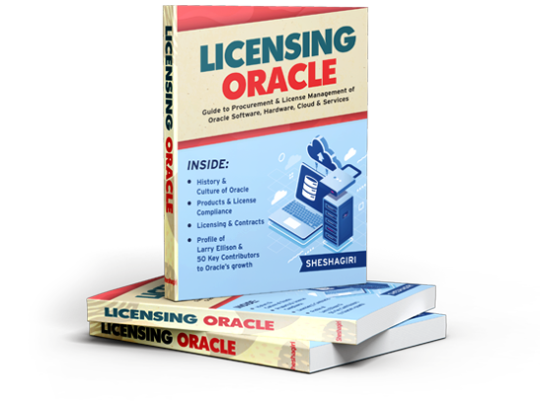
Best Practices for Oracle Licensing on VMware with BYOL
Conduct a License Assessment: Regularly review Oracle license agreements and deployments to ensure compliance.
Optimize VMware Clusters: Use dedicated Oracle clusters to minimize licensing costs.
Implement Affinity Rules: Restrict Oracle workloads to licensed hosts using VMware’s Affinity rules.
Monitor Workload Migration: Prevent Oracle VMs from moving to unlicensed hosts.
Use Third-Party Audit Support: Seek expert guidance during Oracle audits to defend compliance.
Negotiate Licensing Terms: Work with Oracle representatives to clarify BYOL terms for VMware deployments.
Stay Updated on Policy Changes: Monitor Oracle licensing updates to ensure ongoing compliance.
Conclusion
Managing Oracle licensing on VMware requires a strategic approach to minimize costs and ensure compliance. By leveraging Oracle BYOL, organizations can optimize their existing Oracle investments while running workloads efficiently on VMware infrastructure. Understanding Oracle’s licensing policies, implementing best practices, and using compliance tools will help businesses navigate the complexities of Oracle licensing on VMware. With the right approach, enterprises can achieve both cost efficiency and operational flexibility while maintaining compliance with Oracle’s licensing requirements.
0 notes
Text
Resource Grouping in vROps: Tags, Application Groups, and Custom Groups - Finding the Perfect Fit for Your IT Operations!
In the world of IT operations, the ability to monitor and manage infrastructure resources efficiently is critical. With vRealize Operations (vROps), IT teams can use various methods to organize resources, such as Tags, Application Groups, and Custom Groups. Each of these grouping methods offers unique features and benefits, making them ideal for different scenarios. In this article, we will…
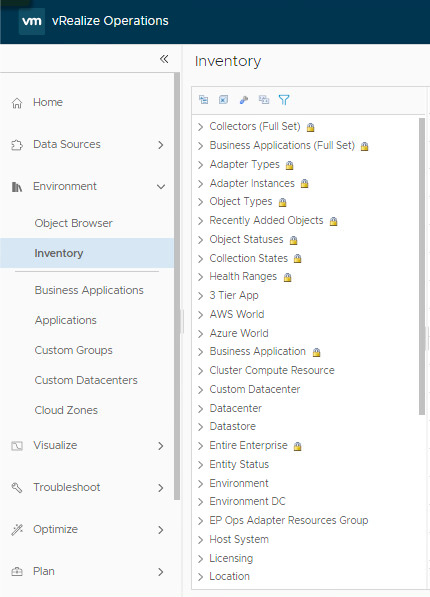
View On WordPress
0 notes
Text
vForum2017に行ってきた!
目次
vForumとは? どんな所? 得た知識(vSphere 6.5 パフォーマンス・ベストプラクティス) 得た知識(vSANから自動化まで!vRealize Operations Manager 6.6 で変わる運用最適化とは?) 得た知識(サポートエンジニアが語るVMware vSphereのトラブルシューティング)
vForumとは?
- VMware社開催の1年に一度、日本で開催される国内ベンダー総集結する事前予約型の大型Forum https://vforum.jp/tokyo/
【開催日】2017年10月31日(火) - 11月1日(水) 【場所】ザ・プリンスパークタワー東京 (地下2階を丸ごと貸切っているけど、人が居すぎて毎年セッションブースがギュウギュウですwww) 内容としては、世界で開催されているVMWorldの日本版(ラスベガスで開催) https://www.vmworld.com/en/us/index.html
どんな所?
主軸は2つ!!!
2日間で国内主要HWベンダーを含む有名企業がVMware社製品を扱った、この日しか聞けないセッションを登壇していて頂き、1コマ約30分~2時間程度開いて頂ける https://vforum.jp/tokyo/program/?src=
- 参加出来なかったセッションは、後日スライドを入手する事も可能だが入手出来なかった場合は、初お披露目だったりする情報や、外部公開が出来ない情報だったりする場合は、二度と知る事は出来ない 図らずも、超希少なセッションだったりする 2. SOLUTIONS SHOWCASEと呼ばれる、ショーケース型のソリューション展示が行われるhttps://vforum.jp/tokyo/program/showcase/expo/?src= - 稀にセッションに登壇されている方が、そのままショウケースにて直接質問出来たりするので、色々と困っている事が解決したりします セッションじゃないからと侮れない!!!
得た知識(vSphere 6.5 パフォーマンス・ベストプラクティス)
包括的な技術情報– VMware Technical PaperPerformance Best Practices for VMware vSphere 6.5 https://www.vmware.com/techpapers/2017/Perf_Best_Practices_vSphere65.html 全編英語だけど、BIOS、CPU、メモリ、ネットワークなどなどVMware社推奨手順が網羅されている 逆に言えば、考慮しない場合、それ相応の覚悟が必要とも言える・・・
Hyper Threading Technology は有効化すべきか? ほとんどの場合、ハイパースレッディングは有効化しておいた方が良い結果を得られるVMkernel は物理CPU、物理コア、論理スレッドの関係を自動的に正確に把握して動作しているVMkernel のスケジューラはハイパースレッディングテクノロジーを十分に意識した設計となっている論理プロセッサー数は多い方がスケジューリング上有利
計算資源が2 倍になるわけではない点に注意※ここ超重要!!!
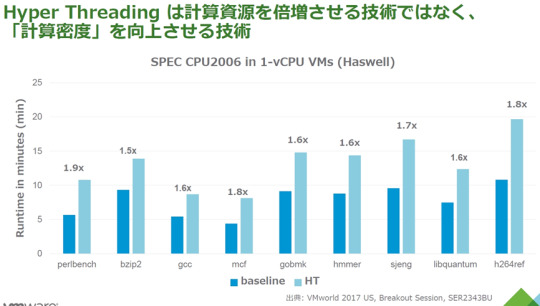
得た知識(vSANから自動化まで!vRealize Operations Manager 6.6 で変わる運用最適化とは?)
仮想化されたことで得られた効果
• CPU やメモリを共有化することにより、物理サーバを仮想リソースに集約 • サーバ台数の削減効果
• 機器の集約により、従来かかっていた人材・工数を大幅に削減 • ソフトウェア化する事で機器調達時間を削減 • 作業工数が数ヶ月から数日(数時間)へ短縮 • サーバシステム全体の最適化により、コスト圧縮
ますます複雑になるIT 基盤どう管理すれば?
• パフォーマンスに影響を与える項目と監視項目が多すぎる! → CPU?、メモリ?、ストレージ?、物理の?、仮想の? • 影響がある範囲が広すぎる! → 隣の仮想マシンのせいでこっちも遅い? → 同じストレージ上にあるから遅い? • なんとなく原因がわかったけど本当にこれでいいの? → 仮想化のオーバーヘッド?サイジング不足?リソースの競合? • ただでさえよくわからないのにHCI? パブリッククラウド? → ストレージが分散されるHCIはどう監視すればいいの? → オンプレとクラウド、どちらの方がいい? お得?
vRealize Operations Manager (vROps) 概要 • 仮想基盤のアラートと統計情報を収集し、それらの情報をあらゆる観点で可視化→ 可視化するために、ダッシュボードという表示形式を提供→ ダッシュボードは事前定義されており、自分でカスタマイズすることも可能
vROps で出来る事 ①問題管理 監視コンソールのようなダッシュボードで、基盤で起こった何らかの問題をアラートとして一元的に表示 • アラートは事前定義されており、必要に応じて追加編集も可能 • 収集した統計情報を元に、システムの標準的なふるまいを自動的に学習し、しきい値を設定
vROps で出来る事 ② パフォーマンス管理 様々なコンポーネントのパフォーマンスを一元的に表示することが可能 • トラブルシューティングといった、目的指向のダッシュボードも提供
vROps で出来る事 ③ キャパシティ管理 中長期的にみたキャパシティ傾向から、今後の予測を含めて可視化 • 仮想マシンに割り当てているが有効活用されていないリソースを、定量的に提示
vROps でできること④構成管理 仮想マシン構成をリスト化したり、統計的にグラフ表示 • VMware 推奨の構成を満たしているかのコンプライアンスチェックが可能
vROps で出来る事 ⑤ 自動レポート機能 収集したデータを使って、構成情報リストやパフォーマンスグラフなどのレポートを作成可能 • レポート作成はスケジュール実行できるので、人手を介さず出力が可能
得た知識(サポートエンジニアが語るVMware vSphereのトラブルシューティング)

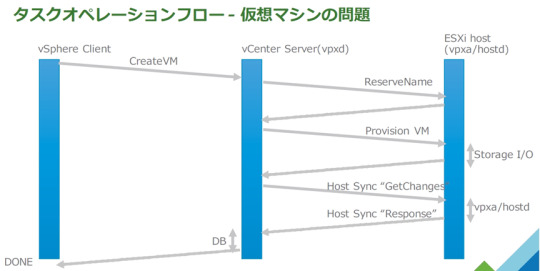
0 notes
Text
VMware Utilizes Its Very own VCloud Director Solution to Strengthen Interior Clouds
When VMware was searching for to merge a lot of of its possess small interior clouds into a single primary cloud for enhanced performance, the company wanted to achieve expertise of firsthand what it requires to run its IT business as an interior provider contributor. Pushed by VMware vCloud Director Cloud management, VMware in the yr 2012 started out on its OneCloud platform that now operates on far more than one particular Lakh virtual devices (VMs) for organizational end users. The resolution has abolished the prerequisite to deal with a whole lot of little techniques, abridged CapEx, increased and automated stability, and shifted internal client fees to OpEx. By now a dependable companion in virtualization, VMware is eager to be serving its clientele securely to just take the fast route about the public cloud, distributing a right hybrid communications that permit affiliation for the development of their knowledge middle resources and restructure IT manage and ability. And the timing could not be improved, as many corporations are coming across the constraints of predicted information center competence. In cooperation of general public and private sectors, conclude-user requires and outlook have twisted unforeseen stages of load on IT personnel tasked with supporting their company' segue to far more hugely designed knowledge center competence. IT leaders across business have experienced to hit the immense steadiness: modernize their info centers whilst going collectively obtainable technologies financial savings and third-party ask for. VMware vCloud Air, the secured general public cloud for VMware workloads, has aided countless determination-makers in this occupation, providing adopters an agile communications that not only will help obtainable purposes, but hold up for application enlargement as effectively. Standard Challenges Before in 2009 and 2010, VMware skilled that numerous of its clientele were experiencing problems with their reallocation to the cloud, and the corporation required to improve and understand the issues these clientele have been experienced to put into apply its goods in real-globe circumstances. In addition, plentiful VMware business models and teams experienced created their own small clouds more than the time and the corporation's recognized "cloud collapse," related to the intensive sprawl affiliation utilized to contract with. The propagation of small clouds was most essential to deprived resource procedure, possible security vulnerabilities, and repetition of endeavours, as effectively as strains the CapEx monetary strategy of some inside of teams. VMware needed to pool possessions to lessen resources requirements, CapEx, and administration costs, whilst also on issue that amplified interoperability and visibility into apply. The aim was to a lot more completely confine the efficiencies and effortlessness of the cloud for inside cloud companies even though having information about the confront its shopper IT affiliation expertise. Answer Provided by VMware VMware started on its OneCloud growth in 2012 partly to merge its dissimilar inside clouds into one particular cloud plan. The OneCloud team depleted a few months operating with structural layout and communications groups, item professionals, and advancement groups to carefully talent a constant architecture. Then they bought the hardware, which comprise a mix of Cisco UCS and VMware Cloud foundation deals that revolve up a Software program-Defined Info Core (SDDC) with equipment from distinct retailer that they manage into a analyzed and authenticated answer, with a modest automation contribution. OneCloud is now sequentially far more than 5 hundred fifty virtual data center environment that are put collectively upon 22 dissimilar cloud functions. The system operates extra than 90,000 VMs with 706 terabytes of recollection and eighteen megabytes of storage space owed, with ninety per cent of those VMs on the vCloud Director coverage. The added ten percent of the VMs are on one particular of the two other cloud firm coverage that OneCloud function: VMware Included OpenStack and the VMware vRealize process Supervisor Resolution. All OneCloud lessee workloads are positioned in OneCloud dependent on their production criticality, unraveling manufacture and nonproduction workloads, with three row of support accessibility. OneCloud geared up teams are prolonged throughout the world, sustaining clientele around the clock. Advancement groups usually perform with clientele to expand new-fangled insert-on providers to fulfill requirements. Group of OneCloud is tasked with affiliation just before launch VMware computer software for handful of months in progress than the software ship, creating as a very last check gate for heart products. The procedure regularly catch slight bug that get spot at tremendous scale and from time to time catches showstopper problems that are tremendously worthwhile to acknowledge. All OneCloud tenant workloads are placed in OneCloud dependent on their company criticality, separating creation and non production workloads, with three tiers of services available. OneCloud geared up teams are extended throughout the globe, sustaining clientele close to the clock. Development team regularly function with clientele to expand new incorporate-on providers to meet up with necessities. vmware training london On-line Education The OneCloud notion has authorized VMware IT staff to exercise and be trained from every single phase of initiation an IT-as-a-support big business, permitting them to improve and appreciate their clientele and put up improved merchandise. All appreciation goes to OneCloud, VMware can now gauge and testimony on operation throughout each and every business unit for the initial instance. This facilitates the enterprise to precisely charge each and every grouping for the definite interior IT providers they employ. Lastly, offered vSphere end users have appreciate chiefly faultless transitions to the community cloud, instantaneously in advance peace of brain and advantage from concentrated day-to-working day strain on IT workers belongings. To get in depth expertise about OneCloud it truly is important to get specialist VMware on-line coaching. By undergoing the VMware certification system from on-line training institute will help you to become prepared to just take on the VCP6-DCV certification and distinct the very same with flying shades. The education team, a profit generating tenant of OneCloud, experienced progressively more demanding the require for on-line coaching and celebration-pushed program in use. OneCloud meet up with its needs by delivering large-performance cloud accessibility services amount agreements (SLAs). Prior to OneCloud, the VMware network stability collection experienced to repeatedly evaluate assorted requests from various teams. By combining to OneCloud, it has a identified architecture with three outlined security zones, each pre authorized by the protection staff.
1 note
·
View note